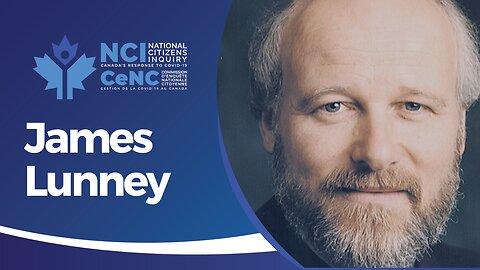James Lunney, a former MP for B.C. and a champion for natural health products, tells the Inquiry of the importance of vitamin D for the body and the lack of vitamin D in most people, especially those in the northern hemisphere. He said, “Well, reports go: nine out of ten COVID deaths could have been prevented if the blood level was elevated. And who’s the most vulnerable? Not racialized Canadians, but people with low vitamin D.”
* The above video is being streamed via Rumble. Check back often as we continue to update the complete list of links to all witness testimonies in both video and audio/podcast formats.
[00:00:00]
Shawn Buckley
So our next witness is James Lunney. James, can you please state your full name for the record, spelling your first and last name?
James Lunney
James Lunney, L-U-N-N-E-Y.
Shawn Buckley
And James, do you promise to tell the truth, the whole truth, and nothing but the truth, so help you God?
James Lunney
I do.
Shawn Buckley
Now, you have had two, I guess, careers. You started practising as a chiropractic doctor back in 1976. And you practised as a chiropractic doctor for 24 years.
James Lunney
Yes.
Shawn Buckley
And then in the year 2000, you entered politics and became a Member of Parliament for the Nanaimo–Alberni riding, and you were first elected as an Alliance MP.
James Lunney
That’s correct.
Shawn Buckley
And then later, when the Alliance Party merged with the Conservative Party, you were a Conservative MP. And you served as a Member of Parliament for that riding until 2015.
James Lunney
Correct.
Shawn Buckley
And then at that time you just resigned from politics altogether. You didn’t even run.
James Lunney
I retired—five times undefeated.
Shawn Buckley
Right okay. Now I will let people know, I’m familiar with Mr. Lunney because—I don’t even know, is it two decades ago? Where we met and you introduced Bill C-420, an Act to amend the Food and Drugs Act.
James Lunney
Yeah, it was before 2004 because it was the first term for me.
Shawn Buckley
Right. And just so— People aren’t aware, so that was an act I had drafted to amend the Food and Drugs Act to protect natural health products. And Mr. Lunney has been a champion in Parliament literally for decades in the area of natural health and trying to protect our health rights and our access to natural health products.
James, you are here today because you want to share with this Commission your thoughts on vitamin D and how that played a role in the COVID pandemic and how we should be addressing vitamin D issues going forward.
James Lunney
Exactly.
Shawn Buckley
You have a presentation. I’m just going to let you launch in. And I’ll let you know if we start running short of time.
James Lunney
The title is, you can see, “Vitamin D3 and COVID, Canada’s Response.” A lot has been said about vitamin D. And I hope today to give you a different perspective, an aspect that hasn’t been discussed. An aspect that hasn’t been caught by a lot of the good doctors because they trust the data that our regulatory authorities, all that Health Canada puts out on a variety of subjects, as authoritative.
I have three objectives here today.
One, to briefly talk about the importance of vitamin D in human health and the pandemic. But to talk about the serum levels that determine the outcomes. Your blood level is what determines the outcomes. And that’s going to vary for individuals depending on your body size and the tone of your skin—I’ll get to that in a minute. But the failure of Health Canada and the Institute of Medicine, which is now known as the National Academy of Sciences, to protect the public interest. And that’s a real phenomenon, I’m afraid to say.
So just a quick thing about vitamin D. Look, here’s an example. There’s three bottles of vitamin D there. On the left is what Health Canada was permitting in Canada. It’s a thousand international units (IU). That was based on an analysis of 600 to 800 and being generous, they rounded up to a thousand IUs. In the middle is a bottle you can pick up in the United States but not in Canada. At the bottom, if you can see that: on the green bottle, there’s a tiny little soft gel there. The middle, 5,000 IUs and then on the right, 10,000 IUs, which are available in the United States but not in Canada.
I just wanted to say that some people might think: if Health Canada actually recommends 4000 IUs as max, that 10,000 might be a lot. Or when the French Academy of Medicine recommends 100,000 IUs to shut down the acute respiratory distress syndrome that could put somebody on a ventilator, that sounds like a lot. But I tell you what: if you knew what an IU is you might get a different perspective. The actual data has been challenged by these two research groups that met with Health Canada. And I’ll want to detail that.
But the first thing I want to say is that who is most vulnerable has not been understood. And many of our good doctors that are speaking about vitamin D and saying 5,000 is part of a recovery program.
[00:05:00]
Well, for the dark-skinned people in Canada—and there’s quite a few now and more coming all the time—Health Canada denies that skin colour makes a difference. And it does.
And I’ll get to that.
But I’ll just say up front: if I fail to get this across, I will have failed in my mission to get some information across to people, so I hope you understand this. And that is, the dark- skinned people— For example, British Medical Journal wrote it up first: Sweden didn’t lock down and forty per cent of the early deaths were Somali immigrants, equatorial people, the darkest skinned. They were working with the mothers, beautiful dark-skinned young women, but if they’d been in the U.K. long enough to go through a winter season, your D depletes by, 35 to 42 days, fifty per cent.
Shawn Buckley
James, can I just slow you down for a sec? Because some people might not understand that vitamin D is a vitamin that the human body manufactures. And we manufacture it when we’re in the sunlight. So when we’re in the winter in the northern hemisphere, we’re not getting much sunlight. For several reasons: it’s cold and we’re all bundled up and then we’re in the northern hemisphere. So some people might not understand what you’re trying to explain without understanding you need to be out, you need to be in the sun to actually have healthy vitamin D levels if you’re not supplementing.
James Lunney
Thank you for clarifying. Exactly. We’ve turned away from the sun for a good part of the year in the northern climates and your D, without supplementation, will deplete by 50 per cent every 35 to 42 days, depending on your body size.
Shawn Buckley
And if I can also interject. And you may want to just explain that vitamin D is an essential vitamin for the healthy immune system. So we hear about vitamin C, but when you’re going to be relating that people are getting sick by not having D, I think you need to back the bus up a little bit and explain why it’s important.
James Lunney
Thank you.
Well, vitamin D drives at least 2,000 genes that are known so far. And they’re involved in, so far we’ve identified three systems: the immune system, inflammation management, and glucose metabolism. And those three systems together are most of our chronic illness. So your blood level of vitamin D is crucial. It’ll be different depending on your body size, how much body fat you have. I’ll just move ahead, but thank you for putting that out there.
How do I know about this file? Well, I had a bill on vitamin D. I may get to it, I shortened my presentation and put the most important stuff first, but I would have established all these things if we had more time.
This reports here—Dr. Malone, you all know. This is a doctor from Italy; this is March. Now that COVID is over, these guys disregarded the advice from their regulatory agencies. They had a friend working in Africa who was getting brilliant outcomes. Even in Africa, there were some COVID cases where there’s brilliant sunlight, but anyway, “We treat COVID at home and the mortality rate is almost zero.”
They had 6,000 cases. This network of doctors, they called themselves after Hippocrates. They just followed their oath to do no harm and to keep the patient’s interest first. Six thousand patients so far, at the time this report was written; mortality is practically zero. And this is Dr. Paolo Martino Allegri. And the oldest patient they treated was 95 years and they were working on somebody who’s 98 with very promising results so far.
Dr. Malone put this out in his Substack. This is a quote from Dr. Malone: “Mortality risk correlates inversely with the vitamin D3 status, and a mortality rate close to zero could theoretically be achieved at 50 nanograms per millilitre.” And that’s American measure. In Canada, we use nanomoles per litre [nmol/L], so you have to multiply by two and a half. So that’s great. At 125 nanomoles per litre, you could have zero.
And I should ask, I wonder how many people in this room have had their blood tested for vitamin D levels? I see a few hands back there. Those are informed people. Did you have to pay for it? Yeah, we have to pay for vitamin D testing. And somebody just told me in Ontario now it’s $140. So that’s a disincentive, I would say. You need to know what your numbers are because it’ll depend on your body type. And vitamin D is fat soluble, so if you have extra weight—including me; I’m losing some weight—it’s fat soluble. Some of that vitamin D will be parked in the parking garage. It will not be in circulation to help the cells that need it around the body.
Okay, so this is Dr. Malone. He says in his own words, “How many people could have been saved from just having their levels of vitamin D3 brought up to 50 nanograms per mL, or higher?”
[00:10:00]
We knew about vitamin D3. It really didn’t take a randomized clinical trial to understand the link between D3 and RNA respiratory virus morbidity and mortality. Vitamin D will shut down respiratory viruses in the lung. It produces specific antiviral peptides and antibacterial peptides, meaning it actually would work for tuberculosis in a respiratory way. IF you have enough in your body. And most people in Canada are low. I’ll get to that statistic in a second.
Okay, so early in 2020 as COVID terror circulated the globe, you can see this, reports from all over the world: severe infections, hospitalizations, and deaths attributed to COVID-19 directly related to the serum levels. Now I mentioned this: in Sweden, 40 per cent of the early deaths were Somali immigrants. I checked afterwards with the U.K. Very early in the pandemic, 25 per cent of the early deaths were Middle East and Southeast Asian, they have a lot of—
Shawn Buckley
I think I need to stop you again so that people understand. We’ve established that you need sunlight on your skin, actually on your skin, to make vitamin D. But the darker skinned you are, the pigment prevents the sunlight from getting through, so it’s harder for you to make vitamin D. When you’re speaking about people that immigrated from Somalia, it’s because of their dark skin; they would need way, way, way, way, way more sunlight to get anywhere near that amount of vitamin D that a Caucasian person, a lighter-skinned person, would manufacture. So that people understand the meaning of what you’re saying.
James Lunney
There’s nothing wrong with their beautiful dark skin, it’s just that that’s population genetics at work. They had to upgrade the melanin production in order to protect themselves from too much sunlight that could damage the DNA. And we pale-faces come from northern climates. We had to down-regulate the melanocyte production in order to let enough sunlight in to be well. So 90 per cent of our vitamin D does not come from food, which is what Health Canada puts out there. They dismiss the importance of the sun because they’re keeping us safe. The secret with the sun would be, don’t burn.
This is an important thing I want to get to here. The vitamin D recommendations were made in error. It was 2010-2011, I could pull that right off the Health Canada website; it’s still there. On November 30th, the recommendations came out. There were 14 experts on the panel. The data they analyzed showed 600 to 800 IUs. They limited the study to bone health and ignored all the data that was available on autoimmune diseases being down, cancers being down, heart disease being down, mental health being up. There was lots of literature then, but the study was restricted to bone health.
Anyway, since then, scientists from the University of Alberta, University of California San Diego, and Creighton University took another look. And they found there was a problem. The problem was the data, even limited to bone health, that they reviewed showed the average person needs 6,000 to 8,000 IUs, not 600 to 800 as they proposed.
Shawn Buckley
You’re meaning daily.
James Lunney
That, as a full order of magnitude, is a significant mistake. Now everybody makes mistakes. But I will witness to this because I had a bill on vitamin D that I introduced in 2012, and the top vitamin D doctors came to Ottawa May 4th, 2014 to try and persuade Health Canada to fix the mistake they made. A total of 15 doctors spoke in turn and Health Canada was represented. The man seemed rather stressed through the day.
At the end of the day, a woman went to the microphone—I found out later she was his boss—and she said, didn’t the people in the room realize how hard Health Canada had been working to figure out how much vitamin D was in a cup of yoghurt and how much was in a cup of milk? Well, it’s nice that there’s a little bit there, but it’s so low. For the needs in the body— there’s 80 to 100 trillion cells in your body. Every single one of them has receptors for vitamin D. And it’s doing something very important because it regulates your immune system, inflammation management, and the glucose metabolism. And possibly others that we haven’t identified so far.
So the average Canadian has a blood level of about 67 nanomoles per litre. Now what Dr. Malone mentioned there was 125 nanomoles per litre. The average Canadian is at 67. But who is the lowest in Canada?
[00:15:00]
That would be the people with the darkest skin tone. And there’s nothing wrong with their beautiful skin. They just need more sun access in order to get their D levels up.
And many of the people from countries with dark skin, they’re very modest, they’re covered most of the time. And Canadians, our numbers are actually dropping. Sixty-seven was average, but that was a while ago, way back in 2010. And they seem to be slow in coming up with new numbers because they don’t seem to want to let people know how important this is.
Health Canada, look: the top line here, mysteriously, just at the beginning of COVID they revised the website. You can see the date at the top, I put it on there: “Health Canada continues to recommend that people over age 50 take a daily supplement of 400 International Units.” You know, that’s a baby dose. Four hundred IUs is a baby dose, one little 400 IU drop. But adults need far more than that to achieve the appropriate blood level.
Now, here we go. There was a study done in Florida, that’s 37th parallel. All the way down there, that’s where the division is, for dark-skinned people below that; they have a hard time north of the 37th parallel. We’re at 40-45 here in Ottawa. North of the 37th parallel, they did a study in mid-Florida. They matched black males, co-matched for age and comorbidities with a white group that were not supplementing. They gave them the maximum Health Canada recommends, 4,000 IUs a day. It’s tested every two months; it took a whole year to catch up with the matched group of white people that were not supplementing. A whole year. So if you want to get your blood level up, you have to supplement. Even in Florida, where there’s lots of sun.
And you know, one of my heroes would be Dr. Mercola. He was in the top 10 misinformation people according to some authorities. I followed Dr. Mercola for years, but even he didn’t recognize vitamin D deficiency in Florida because they had so much sunlight. It’s in the dark-skinned people. If you don’t check their blood levels— That’s why they’re overrepresented in a myriad of diseases: obesity, diabetes, thirteen different cancers. They’re overrepresented because our officials misrepresented how important vitamin D is and don’t tell people.
What is an IU by the way? Who knows? Anybody know what an IU is for vitamin D? I bet if they were all physicians in this room, most of you wouldn’t know, because it’s not a standard you can— Here we have micrograms and milligrams. You might have a chewable vitamin C as 500 milligrams. Or if you go to the hospital with a chest pain, they want you to take two baby aspirins at 81 milligrams. So an IU for vitamin D is 0.025 micrograms. And 100,000, which could have saved a life from the acute respiratory distress syndrome according to the French Academy of Medicine, that’s what they recommended for people heading into acute respiratory distress. A hundred thousand IUs equals 2.5 milligrams.
It is one of the safest things you can take.
If you have an organ transplant you might want to be careful, we can’t overstimulate. But I do know people with organ transplants have successfully taken 5,000 IUs and several that are taking 2,000 a day. You can still take it, but that’s something where you can’t take massive doses. But a short-term dose, it’s not clear. For two or three days, probably would not over-affect— We don’t know for sure. That’s the caution there should be.
All right, going on.
Vitamin D blood levels: the blood levels are so important. You should know what your numbers are. But I know, I’m talking to people here in this room, you know, attending here, who are vitamin D deficient just by the symptoms they’re having. Everything is better when your D levels are up. And if you haven’t tested, you don’t know how bad it is. And if you go to Health Canada’s website, what you will see is a misrepresentation of the truth.
Fifty nanomoles per litre will protect bone health for most Canadians. Great, but experts say raising blood levels to 100 to 150 nanomoles per litre. Dr. Malone was talking about 125 nanomoles per litre and other experts are saying between 100 and 150. It’s clear. It depends on your body size, but the quicker you get your blood levels up when you’re dealing with any serious illness,
[00:20:00]
the better that’s going to work out for you.
Oh, this is the French Academy of Medicine by the way. Right there, 50[,000] to 100,000 IUs in the case of deficiency could help limit respiratory complications.
Okay. We knew this in Canada. This is Edmonton 2015, Dr. Gerry Schwalfenberg. Also, he called out the mistake that Health Canada had made in a letter to the Canadian Medical Association. “Regrettably, a statistical error resulted in erroneous recommendations by the Institute of Medicine leading to this conclusion. It might actually take 8,800 IUs of vitamin D to achieve this level in 97 per cent of the population.” Health Canada was recommending 800. Now, this is a serious public health blunder. That’s 2015 in our own Canadian Medical Association Journal.
He’s an Edmonton doctor. And he and his colleagues, you might see at the bottom of the screen there, “The Vitamin D Hammer.” They get the blood level over 100 nanomoles per litre, they rarely see a patient in their practice, the two of them—in the hospital, according to what he wrote. But if they do end up with one landing in the hospital, they immediately give them what they call The Vitamin D Hammer. And that would be between 50,000 and 100,000—50,000 one-time dose in one day, or 30,000 (10,000 three times a day) for three days, and it’s gone.
So that’s a pretty powerful medicine and virtually, it’s without complications. Now this is from Medscape. The key to managing the sun is: do not burn. It’s estimated if you had full-body exposure, just until you get a little bit of pink on you, that would produce 20,000 to 25,000 IUs. It’d take a long time to get there at 400 a day—a baby dose.
There’s the question I already asked you, so we’ll move on. You should know what your levels are and it’s outrageous we have to pay for them.
By the way, the story on that is that our own physicians in Ontario persuaded the government to stop testing for vitamin D because Health Canada said 1000 is enough and they were negotiating for a fee increase. And they—actually, I couldn’t believe this when I read it—they were working with the government to identify unnecessary procedures. So “save the public purse,” you know? That’s the story here.
Now: save lives, reduce deaths. You raise the levels between 100 and 150 nanomoles per litre, a 50 to 80 per cent reduction in breast and colorectal cancers. That’s published literature. They expect a reduction of three-quarters of the deaths from breast and colorectal cancers. That’s something the public should be interested in, I would think. Garland et. al. is that article on the front of the slide. It’s Epidemiology, that’s 2009.
Now, here’s the issue about the skin and vitamin D. Health Canada dismisses the role of skin colour and vitamin D. This is from their own website: “Additional requirements are not required for sub-populations such as those at higher latitudes and those with dark pigmentation or those wearing heavy clothing that inhibits the sun.” The lowest vitamin D levels they’ve measured anywhere in the world is in an area with a lot of sunlight. And they’re people wearing a burka in the Middle East. They’re clothed. But you see, the UV light doesn’t get through clothing. It’s filtered out. And that’s a strange thing, but that’s where it’s at.
So just to illustrate this, I’ve jumped right ahead here in the presentation to the closing of our meat plants. Our Cargill plant was shut down. Cargill in High River, Alberta: 2,000 employees. Seventy per cent of them are Mexican, Filipino, Vietnamese and, you know, other dark-skinned people—70 per cent of the workforce. And yet it caused terror for the town because of the test. A lot of people tested positive; a few were getting sick. The headlines are about cold, crowded circumstances there that causes this.
But, what’s the vitamin D level for these people? The longer they’re in Canada, they’re the lowest in Canada.
[00:25:00]
And it’s easily remedied and cheap. But there’s no mention of that from Health Canada. Unfortunately, it’s dismissed.
By the way, the Inuit would have died out if it was not for their traditional diet where they ate the mammal blubber. The mammal blubber of course is where the vitamin D is stored. I know, time is sensitive, so I’m trying to get some of this in.
By the way, in Hazleton, the meat plant quickly became the area’s biggest private employer. It’s an hour from New York. Largely from Dominican families like the Benjamins. And the Latino population jumped sevenfold from 2000 to 2010, to 37 per cent of the city’s inhabitants, and has risen to more than 60 per cent.
And many of them in the meat plant are like this man I’m going to introduce you to here.
This is Raphael Benjamin. Thousands of these workers. This man—I tell you, I wept when I read this—this man was just before his retirement. He wanted to top up his pension. His family wanted him to quit and get out of there because people were testing positive. Well, he was admitted to the intensive care unit and spent his work anniversary on a ventilator. He died on April 19th.
This is criminal and the people responsible for this need to be held accountable. Can we say it’s the vitamin D level? There’s enough studies to verify that dark-skinned people without supplementation are the lowest, even north of the 37th latitude.
Shawn Buckley
Now James, if we can just kind of focus this back on COVID.
James Lunney
Yes. But that’s a COVID death.
Shawn Buckley
Right.
James Lunney
And I’ll tell you what. In Canada, Health Canada put out statistics: Toronto and Montreal, hardest hit. They called them racialized Canadians.
Shawn Buckley
As COVID deaths.
James Lunney
COVID deaths—hardest hit in Canada.
Shawn Buckley
You’re basically saying that it’s a co-factor to be considered when we’re assessing mortality and hospitalizations related to COVID, having a look at the vitamin D levels in the blood.
James Lunney
Well, reports go: nine out of ten COVID deaths could have been prevented if the blood level was elevated. And who’s the most vulnerable? Not racialized Canadians, but people with low vitamin D. And there’s some in the room here today.
So 115 meat and poultry plants reported COVID infections: 5,000 workers. That’s a 500,000 workforce. There were 20 deaths amongst them. If you look at mortality, like Dr. Rancourt the other day, you won’t see where this is coming from—if you only look at the deaths. But if you look at who’s dying, you see that they’re mostly dark-skinned people. Not always, it depends. There’s lots of shut-in seniors. But the darker the skin, the lower the vitamin D, so it’s your serum level. The question would be, how were their employees’ vitamin D levels?
Here is just another Israeli study. All over the world, these studies were coming in. That’s still 2020. Real world data. They found a vitamin D deficiency and infection relationship. Israel, like Florida, most of the physicians were not looking for vitamin D deficiency. But the deaths in Israel—
Shawn Buckley
James, I’m just I’m going to cut you short because we’re short on time. So I’m going to the commissioners if they have any questions.
James Lunney
Can I finish the sentence?
Shawn Buckley
You can finish the sentence.
James Lunney
Most of the severe infections were in the people covered up. That would be the Orthodox Jewish people wearing the dark clothing and dark hats for the men and the Arabs were in the traditional galabeya and keffiyeh. So they’re covered even though there’s intense sunlight. Okay.
Shawn Buckley
Thank you. I’ll ask the commissioners if they have any questions. And they don’t.
So James, on behalf of the National Citizens Inquiry, sincerely thank you for coming and testifying today.
James Lunney
Thank you.
[00:29:05]
Final Review and Approval: Jodi Bruhn, September 6, 2023.
The evidence offered in this transcript is a true and faithful record of witness testimony given during the National Citizens Inquiry (NCI) hearings. The transcript was prepared by members of a team of volunteers using an “intelligent verbatim” transcription method.
For further information on the transcription process, method, and team, see the NCI website:
About these Transcripts
Summary
Mr. James Lunney is a former MP in B.C., now retired. When he was in politics he presented Bill C420 to amend the Food and Drug Act. James is giving his testimony on the importance of Vitamin D for overall health and in particular, presenting evidence that it was instrumental in preventing and recovering from COVID. Health Canada, as recently as last November, recommend 600-800 IUs for bone health but didn’t study the effects for autoimmune diseases, cancers, heart disease or mental health. Since then, a study done by scientists from three universities found that, for the average person, 6,000-8,000 IUs per day are necessary even for bone health.
Dark skinned people in the northern hemisphere are in particular need of supplements as the sunshine is more difficult for them to absorb. Weight and exposure to sunlight are factors for everyone and James says blood analysis is crutial for everyone so they are aware of their Vitamin D levels. James testifies that the reports say nine out of ten COVID deaths could have been prevented if vitamin D levels were elevated in the blood.






















